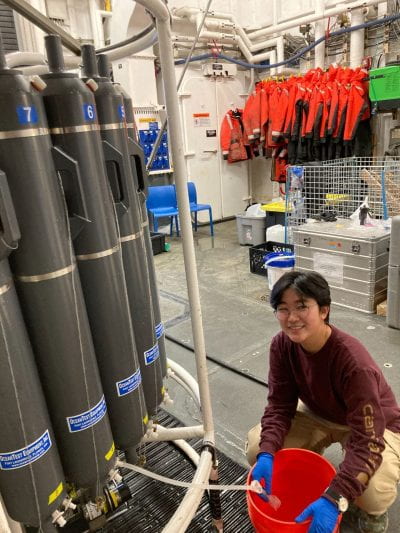Deep Dive in 5: Explore the Arctic Circle with Incoming Graduate Student Jo Kaya

Biological Oceanography graduate student, Jo Kaya, drills through sea ice to sample water in the Arctic Chukchi Sea.
During summer vacation, many may run toward the beach, but incoming SJSU graduate student Jo Kaya, ’25 Marine Science, headed to the never-ending sunshine of the Arctic Circle to research phytoplankton and their role in the food chain of the Chukchi Sea. In this Deep Dive in 5, learn more about the research Kaya participated in and what it is like to go 45 days without internet access.
What program are you joining at MLML and SJSU, and why did you choose to pursue your studies with us?
Jo Kaya (JK): I am joining Dr. Sarah Smith’s Lab in the Biological Oceanography program at Moss Landing Marine Laboratories (MLML). I chose to pursue my degree at MLML due to its unique setting in which graduate students and their research are the primary focus. Having earned my BS at a relatively large school, I knew that a smaller program would be a better fit for me and my journey in higher education.
Tell us the purpose of the trip, and run us through a quick-day-in-the-life of Jo on the ice?
JK: There were a few different objectives of this cruise; however, the overall goal was to research the fate of primary production (food material available to sea creatures) in the Chukchi Sea, west of Alaska.
My assigned shift aboard the R/V Sikuliaq, an American research vessel, went from 3 p.m. to 3 a.m. At the start of each shift, the chief scientist would list all of the open water and ice stations that we hoped to cover within the next 12 hours. Funnily enough, most of my responsibilities did not involve going out on the ice (although it did make for a nice photo). I actually spent a vast majority of my time collecting water samples off of the CTD, an instrument that measures conductivity, temperature and density in the water profile, and running nitrogen growth experiments. I also helped sample the sediment off of the multi corer and prepped nutrient samples that will be analyzed by another scientist at a later time. In between stations, if there was down time, folks on my shift liked to play board games, ping pong and/or just chat and have what we called a “Table Talk Session..
Jo Kaya works with sea water samples on board the R/V Sikuliaq, an American research vessel in the Chukchi Sea.
JK: I think the most unusual thing I experienced was being in broad daylight 24 hours a day. The sun literally never went down over the course of the entire cruise, which was mildly disorienting for the first week or so. I had made an ongoing joke with a fellow student about how we felt like the whole cruise was just one very long day. When we arrived back on land, we looked at each other as the sun was finally setting and could not stop laughing because we were both thinking the same thing. The long day was finally over! Which was sad and nice at the same time.
Why should fellow students consider pursuing your line of research? What’s the most interesting thing about it?
JK: To be honest, this cruise and my admission to MLML is my very first experience working as a scientist in oceanography. All of my previous work has actually been in agronomic research in The Palouse, a region that encompasses parts of Eastern Washington and North Central Idaho. What prompted me to make this seemingly big career change was actually a hobby that I picked up during the pandemic – planted aquariums (gardened aquariums with aquatic plants). I developed a genuine interest in marine science and spent the better part of the last year and a half debating whether or not to take that risk and go for it. After a lot of thought and research, I ended up applying to MLML and was very pleased (and also a little shocked) when I was accepted.
With my somewhat limited knowledge, I think I can encourage students to pursue biological oceanography because it can take you to places that not many people get to see. How many folks can say that they’ve crossed the Arctic Circle, walked on sea ice and had a drink of fresh ice melt? It was the most unique experience I have had with field work in science, bar none.
I think the most interesting thing about this type of work was having the opportunity to go on a research cruise. We lived on the Sikuliaq for 45 days without cell reception and very limited Internet access. As an aside, one of the biggest shocks for all of the scientists was not being able to stream anything, including music on Spotify. It left us with a lot of time to gaze out at the scenery and observe the local wildlife. For example, the coolest thing folks on the night shift got to see was a mama polar bear and her two baby cubs!
Is there anything new or unexpected that you’re learning/discovering on this trip?
JK: Yes! I had originally accepted Dr. Smith’s offer thinking that I was done with field work. I did a lot of field research as a crop scientist and thought that I was ready to just sit in a lab and run experiments. However, this cruise really changed my perspective and I’m now hoping to be able to incorporate as much field work in my future career as possible!
Learn more about MLML research in the spring/summer edition of Washington Square: The Magazine.




